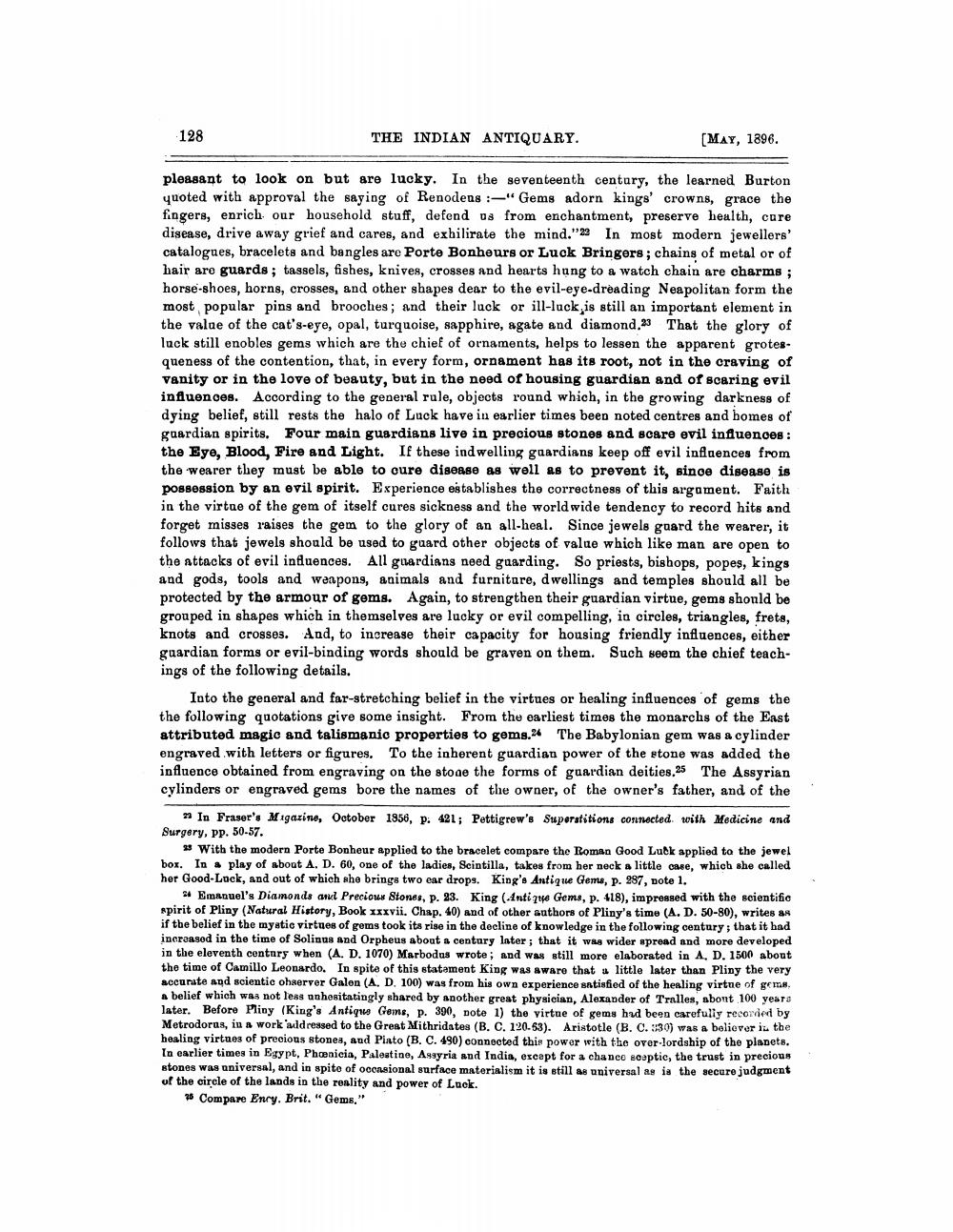________________
128
THE INDIAN ANTIQUARY.
[May, 1896.
pleasant to look on but are lucky. In the seventeenth century, the learned Burton quoted with approval the saying of Renodens :-"Gems adorn kings' crowns, grace the fingers, enrich our household stuff, defend us from enchantment, preserve health, care disease, drive away grief and cares, and exbilirate the mind."22 In most modern jewellers' catalogues, bracelets and bangles are Porte Bonheurs or Luck Bringers; chains of metal or of hair are guards; tassels, fishes, knives, crosses and hearts hung to a watch chain are charms; horse-shoes, horns, crosses, and other shapes dear to the evil-eye-dreading Neapolitan form the most popular pins and brooches; and their lack or ill-luck is still an important element in the value of the cat's-eye, opal, turquoise, sapphire, agate and diamond 23 That the glory of luck still enobles gems which are the chief of ornaments, helps to lessen the apparent grotesqueness of the contention, that, in every form, ornament has its root, not in the craving of Vanity or in the love of beauty, but in the need of housing guardian and of scaring evil influences. According to the general rule, objects round which, in the growing darkness of dying belief, still rests the halo of Luck have in earlier times been noted centres and homes of guardian spirits. Four main guardians live in precious stones and scare evil influences : the Eye, Blood, Fire and Light. If these ind welling guardians keep off evil influences from the wearer they must be able to cure disease as well as to prevent it, since disease is possession by an evil spirit. Experience establishes the correctness of this argament. Faith in the virtue of the gem of itself cures sickness and the world wide tendency to record hits and forget misses raises the gem to the glory of an all-heal. Since jewels guard the wearer, it follows that jewels should be used to guard other objects of value which like man are open to the nttacks of evil influences. All guardians need guarding. So priests, bishops, popes, kings and gods, tools and weapons, animals and furniture, dwellings and temples should all be protected by the armour of gems. Again, to strengthen their guardian virtue, gems should be grouped in shapes which in themselves are lucky or evil compelling, in circles, triangles, frete, knots and crosses. And, to increase their capacity for housing friendly influences, either guardian forms or evil-binding words should be graven on them. Such seem the chief teachings of the following details.
Into the general and far-stretching belief in the virtues or healing influences of gems the the following quotations give some insight. From the earliest times the monarchs of the East attributed magic and talismanic properties to gems.2 The Babylonian gem was a cylinder engraved with letters or figures. To the inherent guardian power of the stone was added the influence obtained from engraving on the stone the forms of guardian deities.25 The Assyrian cylinders or engraved gems bore the names of the owner, of the owner's father, and of the
In Fraser's Magazine, October 1956, p. 421; Pettigrew's Superstitions connected with Medicine and Surgery, pp. 50-57.
» With the modern Porte Bonheur applied to the bracelet compare the Roman Good Luck applied to the jewel box. In play of about A. D. 60, one of the ladies, Scintilla, takes from her neck a little case, which she called her Good-Lock, and out of which she brings two ear drops. King's Antique Gem, p. 287, note 1.
* Emanuel's Diamonds anul Preciow Stones, p. 23. King (Anti Gems, p. 418), impressed with the scientific spirit of Pliny (Natural History, Book xxxvii, Chap. 40) and of other authors of Pliny's time (A. D. 50-80), writes as if the belief in the myatio virtues of gems took its rise in the decline of knowledge in the following century, that it had increased in the time of Solinus and Orpheus about a century Inter; that it was wider spread and more developed in the eleventh century when (A, D. 1070) Marbodus wrote; and was still more elaborated in A, D. 1500 about the time of Camillo Leonardo. In spite of this statement King was aware that a little later than Pliny the very accurate and scientie ohaerver Galen (A, D, 100) was from his own experience satisfied of the healing virtue of gems. a belief which was not less unhesitatingly shared by another great physician, Alexander of Trulles, about 100 years later. Before Miny (King's Antique Gems, p. 390, note 1) the virtue of gems had been carefully recorded by Metrodorus, in a work addressed to the Great Mithridates (B. C. 120-53). Aristotle (B. C. 30) was a believer in the healing virtues of precious stones, and Pinto (B. C. 490) connected this power with the over-lordship of the planets. In earlier times in Egypt, Phoenicia, Palestino, Assyria and India, except for a chance soaptie, the trust in precious stones was universal, and in spite of consional surface materialism it is still as universal ag ia the securo judgment of the circle of the lands in the reality and power of Luck.
76 Compare Enry. Brit. "Gems."




